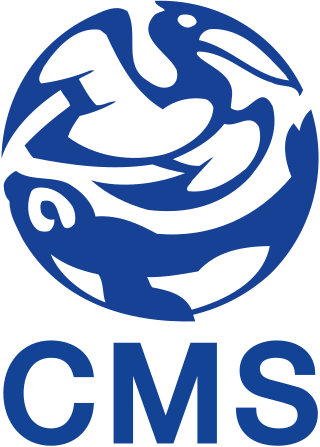
The aquatic warbler is an Old World warbler in the genus Acrocephalus. It breeds in temperate eastern Europe and western Asia, with an estimated population of 11,000-15,000 pairs. It is migratory, wintering in west Africa. After many years of uncertainty, the wintering grounds of much of the European population were finally discovered in Djoudj National Bird Sanctuary, Senegal, with between 5,000 and 10,000 birds present at this single site. Its south-westerly migration route means that it is regular on passage as far west as Great Britain and Ireland.

Monk seals are earless seals of the tribe Monachini. They are the only earless seals found in tropical climates. The two genera of monk seals, Monachus and Neomonachus, comprise three species: the Mediterranean monk seal, Monachus monachus; the Hawaiian monk seal, Neomonachus schauinslandi; and the Caribbean monk seal, Neomonachus tropicalis, which became extinct in the 20th century. The two surviving species are now rare and in imminent danger of extinction. All three monk seal species were classified in genus Monachus until 2014, when the Caribbean and Hawaiian species were placed into a new genus, Neomonachus.

The Mediterranean monk seal is a monk seal belonging to the family Phocidae. As of 2015, it is estimated that fewer than 700 individuals survive in three or four isolated subpopulations in the Mediterranean, (especially) in the Aegean Sea, the archipelago of Madeira and the Cabo Blanco area in the northeastern Atlantic Ocean. It is believed to be the world's rarest pinniped species. This is the only species in the genus Monachus.

Ras Nouadhibou is a 60-kilometre (37 mi) peninsula or headland divided by the border between Mauritania and Western Sahara on the African coast of the Atlantic Ocean. It is internationally known as Cabo Blanco in Spanish or Cap Blanc in French.

The Convention on the Conservation of Migratory Species of Wild Animals, also known as the Convention on Migratory Species (CMS) or the Bonn Convention, is an international agreement that aims to conserve migratory species throughout their ranges. The agreement was signed under the auspices of the United Nations Environment Programme and is concerned with conservation of wildlife and habitats on a global scale.

The south Andean deer, also known as the southern guemal, south Andean huemul, southern huemul, or Chilean huemul or güemul, is an endangered species of deer native to the mountains of Argentina and Chile. Along with the northern guemal or taruca, it is one of the two mid-sized deer in the Hippocamelus genus and ranges across the high mountainsides and cold valleys of the Andes. The distribution and habitat, behaviour, and diet of the deer have all been the subject of study. The viability of the small remaining population is an outstanding concern to researchers.

The Memorandum of Understanding (MoU) concerning Conservation Measures for Marine Turtles of the Atlantic Coast of Africa is a 1998 multilateral environmental memorandum of understanding that entered into effect on 1 July 1999 under the auspices of the Convention on Migratory Species of Wild Animals (CMS), also known as the Bonn Convention. The MoU focuses on the protection of six marine turtle species that are estimated to have rapidly declined in numbers along the Atlantic Coast of Africa. The MoU covers 26 range States. As of May 2013, 23 range States have signed the MoU.

The Memorandum of Understanding on the Conservation of Migratory Sharks is an international instrument for the conservation of migratory species of sharks. It was founded under the auspices of the Convention on the Conservation of Migratory Species of Wild Animals.
The Memorandum of Understanding (MoU) Concerning Conservation, Restoration and Sustainable Use of the Saiga Antelope is a Multilateral Environmental Memorandum of Understanding and came into effect on 24 September 2006 under the auspices of the Convention on Migratory Species of Wild Animals (CMS), also known as the Bonn Convention. The MoU covers five range States, all of which have signed. A number of cooperating organizations have also signed the MoU.

The Memorandum of Understanding (MoU) concerning Conservation and Restoration of the Bukhara Deer is a Multilateral Environmental Memorandum of Understanding and was concluded in 2002 under the auspices of the Convention on Migratory Species of Wild Animals (CMS), also known as the Bonn Convention, in collaboration with the Central Asia Programme of the World Wide Fund for Nature (WWF). The MoU covers five range States. As of August 2012, four of them had signed the MoU, as well as a number of cooperating organizations. The MoU came into effect on 16 May 2002.

The Memorandum of Understanding (MoU) for the Conservation of Cetaceans and their Habitats in the Pacific Island Region is a Multilateral Environmental Memorandum of Understanding concluded under the auspices of the Convention on Migratory Species of Wild Animals (CMS), also known as the Bonn Convention, and in collaboration with the Pacific Regional Environment Programme (SPREP). The MoU provides an international framework for coordinated conservation efforts to improve the conservation status of the Pacific Islands Cetaceans and came into effect on 15 September 2006.

The Memorandum of Understanding (MoU) Concerning Conservation Measures for the Siberian Crane is a Multilateral Environmental Memorandum of Understanding and came into effect on 1 July 1993 and was amended in January 1999. It was the first MoU to be concluded under the auspices of the Convention on Migratory Species of Wild Animals (CMS), also known as the Bonn Convention, and focuses on conserving the Siberian crane as one of the three rarest crane species. The MoU covers twelve range states. As of August 2012, eleven range states have signed the MoU.

The Memorandum of Understanding (MoU) concerning Conservation Measures for the West African Populations of the African Elephant is a Multilateral Environmental Memorandum of Understanding and was launched under the auspices of the Convention on Migratory Species of Wild Animals (CMS), also known as the Bonn Convention, on 22 November 2005, in close cooperation with the African Elephant Specialist Group (AfESG) of the IUCN Species Survival Commission (IUCN/SSC). The MoU covers thirteen range States, all of which have signed the MoU.

The Memorandum of Understanding (MoU) Concerning the Conservation of the Manatee and Small Cetaceans of Western Africa and Macaronesia is a Multilateral Environmental Memorandum of Understanding and entered into effect on 3 October 2008 under the auspices of the Bonn Convention. The MoU covers 29 range States. As of August 2012, 17 range States have signed the MoU, as well as a number of cooperating organizations.

The Memorandum of Understanding (MoU) on the Conservation and Management of Middle-European Populations of the Great Bustard is a multilateral environmental memorandum of understanding and was concluded in 2000 under the auspices of the Convention on Migratory Species of Wild Animals (CMS), also known as the Bonn Convention, and came into effect on 1 June 2001. It aims to protect the Middle-European populations of the great bustard and to manage modern agriculture throughout its range in Central Europe in order to save the remaining individuals. The MoU covers 17 range states. As of August 2012, 13 range states have signed the MoU as well as a number of cooperating organizations.

The Memorandum of Understanding (MoU) on the Conservation of High Andean Flamingos and their Habitats is a multilateral environmental memorandum of understanding that was concluded under the auspices of the Convention on Migratory Species of Wild Animals (CMS), also known as the Bonn Convention. The MoU came into effect on 4 December 2008 and provides protection for the populations of high Andean flamingos, which have been subject to drastic reduction and fragmentation of their habitats and have a delicate state of conservation. The MoU covers four range states. As of August 2012, three range states have signed the MoU.

The Memorandum of Understanding (MoU) concerning Conservation Measures for the Aquatic Warbler is a multilateral environmental memorandum of understanding concluded in 2003 under the auspices of the Convention on Migratory Species of Wild Animals (CMS), also known as the Bonn Convention. This MoU provides the basis for governments, NGO's and scientists to work together to save the aquatic warbler, Europe's rarest songbird. The MoU covers 22 range states. By August 2012, 16 range states and two cooperating organizations had signed the MoU.

The Memorandum of Understanding (MoU) on the Conservation of Southern South American Migratory Grassland Bird Species and Their Habitats is a Multilateral Environmental Memorandum of Understanding concluded under the auspices of the Convention on Migratory Species of Wild Animals (CMS), also known as the Bonn Convention and became effective on 26 August 2007. Under the “umbrella” of the CMS, the governments of Argentina, Bolivia, Paraguay and Uruguay agreed to work together towards better conservation of migratory species of grassland birds of Southern South America. The MoU covers five range States, all of which have signed.

The Memorandum of Understanding (MoU) concerning Conservation Measures for the Ruddy-headed Goose is a Bilateral Environmental Memorandum of Understanding between Argentina and Chile and was concluded under the auspices of the Convention on Migratory Species of Wild Animals (CMS), also known as the Bonn Convention. The MoU was concluded as part of the Special Protocol on the Conservation of Wild Fauna and Flora, signed by Argentina and Chile in 2002, and entered into effect on 21 November 2006. It focuses on the protection of the mainland population of the ruddy-headed goose. The MoU is exclusively South American and covers two range States, both of which have signed.
The Memorandum of Understanding on the Conservation of Migratory Birds of Prey in Africa and Eurasia is an international, legally non-binding agreement to protect migratory birds of prey.



















